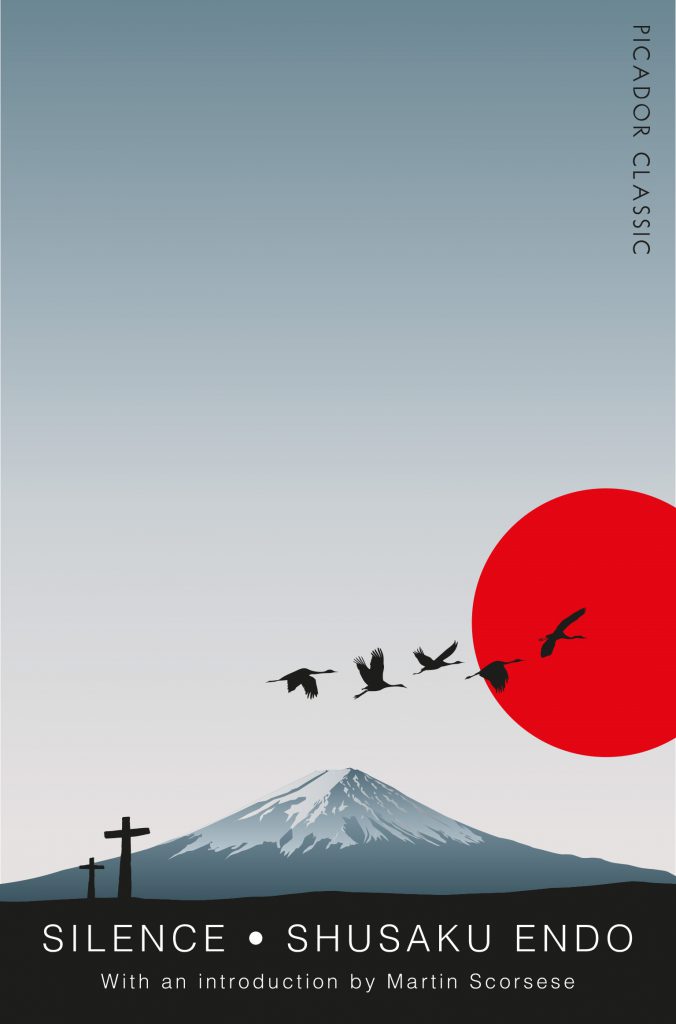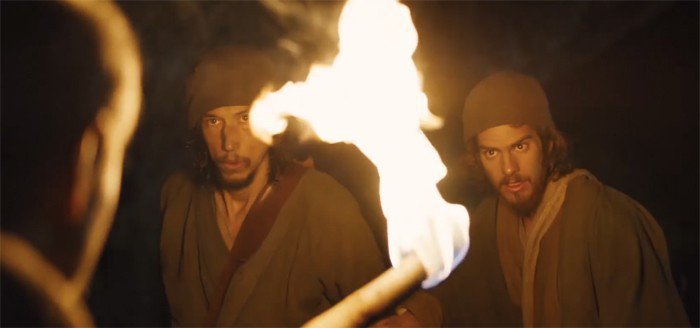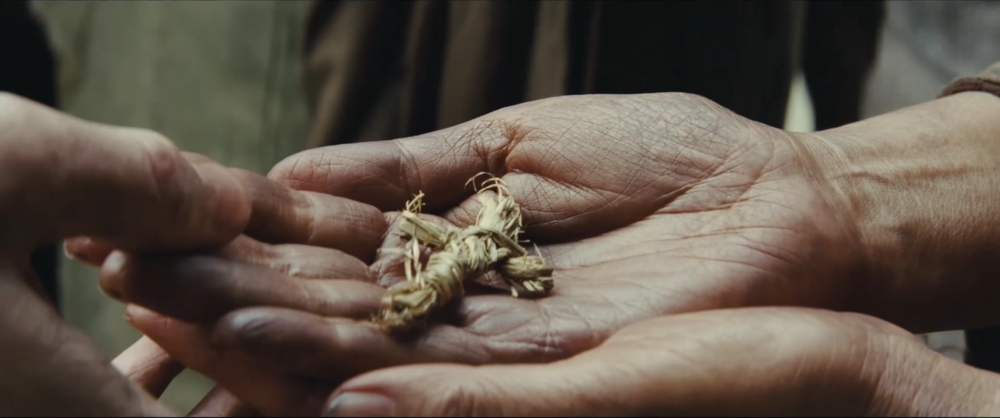

The camera hovers over a swelling sea, looking down, and a boat glides from the bottom of the frame, up through the middle, and passes, steady, up the frame and out through the top. The camera pans out slowly, the boat slowly being swallowed by the scale of the world it inhabits. Just as the stern goes out of view and the ocean dominates the screen, the camera cuts away.
This is the world of Scorsese’s Silence, a place beautiful and alluring, but dark, chaotic, and threatening. The sea holds danger, chaos, and the boat’s stately but frail procession across the screen leaves no trace behind. Amidst this gorgeous world, small gestures of love and big gestures of violence happen, pass, and leave the land behind them, unchanged.
Imperial Japan’s inquisition, under the frail, chirruping Inoue, wields an elegant brand of violence. Absent are the fists, the cudgels, or the whips; instead, they fix the bodies of Christians helpless against the elements, arraying their souls against the most inexorable natural foes: fire, water, and the stolid trickle of one’s blood into the Pit. “It is not I who has defeated you,” Inoue reassures a fallen priest, more truly than he knows.
That violence leaves no scars on the land, no marks of any kind. After three Christian hostages are given to the sea, left on crosses to be beaten to death by the waves, the inquisitors pull them up. Here there are no heads on the bridge for warning, no crosses left by the ocean, no living symbols of the price of defiance. The land has no memory; the world keeps turning. Like a stone dropped into a still lake, the drowned Christians leave no trace of their passing. For the missionaries, that silence of futility is the hardest thing, the despair of dying in agony, leaving no trace of one’s presence, no “butterfly effect,” no impact at all on the world one departs. That futility haunts the film throughout.
Though it’s not the film’s central aim, it partly deconstructs the notion of fault. The waste of the Church plagues the missionaries; they worry their coming has only made things worse for the Christians of Japan. Did the Padres sin, through arrogance or doubt, through carelessness? In trying to do too much, to become all things to all people, perhaps they grew too big a profile and caught the attention of the inquisitors. But the most prominent sense of fault is that the Fathers find themselves helpless before the people’s faith, utterly incommensurate to the welcome, to the adoration which greets them in Japan. The people thirst for the Eucharist, for baptisms by true priests, from across the sea. But their faith seems pristine next to the Fathers’ doubt; the people’s joy from the sacraments completely asymmetric to any virtue of the tattered vessels performing them.
And there is a hate incommensurate to the religion which draws it out, and love incommensurate to its object. Nothing in this world quite makes sense, in ordinary terms. But that incommensurability enchants Scorsese’s Japan: when such love must be transmitted through such paltry vessels (stormy Father Garupe, or Rodrigues’s blunt-chiseled cross), they become loci of an abundant meaning. Once all the signs of faith are scraped away, suppressed, excised, what remains of the faith itself?
The priests speculate that the people only love the signs of faith, the trinkets onto which they can fasten whole matrices of peasant superstition. The Fathers are wrong, there at least: Europe brims with the externals of faith – gorgeous churches, untold ecclesial power, altars and chalices of the most precious substances and workmanship – but in Japan, all the meaning we place on those signs must be compressed into faith in a little reedy cross. That is their consolation, and when the signs of faith fall scarce, they must bear that much more meaning.
The problem is the absence of Christ, which has harried both the Church and the souls of believers for almost two millennia. Europe has no Christ, and neither does Japan; we must find surrogates for Christ’s presence wherever we can. But in Japan those surrogates are scarce, which is why the Fathers bear so much hope. And the Fathers’ concern that the people only love the signs of faith will be revisited upon them, for the Fathers too love the signs of faith: they love the growth of the church in Japan, they love their Order back home, and they love the resilience of their old Confessor, Father Ferreira. The film strips from them all of these things.[1] Once the signs of faith are scoured from the surface of the pristine world, what is left?
* * *
While absence (silence) bears down as the film’s primary antagonist, nature presents a second. And it is the film’s treatment of nature which makes it so effective, which takes it beyond what I had feared it would be – just another ‘doubt’ flick. Admittedly the film’s symbolic universe at times comes across as confused, almost incoherent. A cock crows after Rodrigues’s denial, evoking Peter, despite the Voice of Christ’s invitation to trample him. The bags of silver – rewards for the Inquisition’s cooperators – calls up Judas, rather bluntly. At times the wind blows, alluding to the Spirit, perhaps, or emphasizing the priests’ isolation – it’s hard to say which. Perhaps a more generous viewer could reconcile all of this – say, read it as a sign that God’s love, as well as his providence, encompass betrayers and deniers, or that we can perceive the Spirit only after the scourings of our tangible consolations, et cetera. But it all seems a bit too big, too sprawling, to really land home in a normal viewing.
Still, that sense of finding oneself overwhelmed works in one major way: it is the world which batters, sometimes breaks, and always, if we are honest, perplexes us. God’s presence can always first be felt as Creator, known in his world: the land speaks of God (Rm 1:20). But if it does, why do we find it so empty and merciless? The ever-present mists of Scorsese’s Japan conceal both dangers and hopes, forcing the priests to walk in blindness. When the boat on the sea – here, as in the Gospels, a symbol of fragile refuge amidst the chaos around us – is assailed by hands rising up out of the water, we cannot immediately tell whether they are friends or foes, but we recoil, like Rodrigues, in terror.
In the film’s most picturesque scene, three Christians are hung up on the seashore to be killed, horrifically, by the slow and inexorable beating of the waves. As the waves wear down the land over centuries, they destroy the frail human bodies here in just four days (less, for two of them). Each wave is a beauty and a horror, splashing, flecking, and grinding on the believers fastened in its path. If God created the world, why is the sea so untameable, so deadly?[2] Why the spasms of grief, despair, emptiness, and desolation which assail the human spirit? Why would we be born into such a world?
Scorsese’s Japan (rather like Coppola’s Cambodia) presents an opportunity for the missionaries to enter the world itself, devoid of the props and crutches – the signs of consolation – built up to blunt the edge of religious despair in the Christian West. Everything is shorn from the priests, ending with even Rodrigues’s morality, his faithfulness to his God. “Naked I came from my mother’s womb, and naked shall I return there.” (Job 1:21). That is the courage of Scorsese’s film: its willingness to show nature as hostile amidst its beauty, to strip away everything, all signs of God’s presence, and see what faith, what kernel of hope, is left amidst the “naked shingles” of bare human existence, without its consolations.
Perhaps one could stretch to make a connection between Ferreira’s (straw-mannish) reference to animism and the sufferings of the world: the inquisitors will make the Christians bend to the power of the sea, to acknowledge the primacy of the elements over all human efforts. I think a bit of Cavanaugh’s theology of torture, the horror of the use of the body against the spirit. The Inquisition harnesses not just the body, but also creation, against the souls of the believers. With such opposition arrayed against them, where do the believers find their strength?
Scorsese can be forgiven for not quite answering the questions he poses. I think a bit of King Lear, how the work’s questions are so big and so ambitious that it is impossible to resolve them, or even hold them together, within a stage or the four corners of a screen. The film wisely doesn’t try to encompass these questions within a score – notably absent – or any neat plot tricks or easy answers.
 That’s part of what makes it a little jarring when the film does provide God’s presence, anyway, in Christ’s voice. That voice either (1) dispenses with the formalities of trampling the image, in which case it takes something away rather than providing something, or (2) represents an anthropomorphization, a post hoc justification for Rodrigues’s decision. It seems a little too much turns on how one resolves that ambiguity; the ethical issue there sort of draws excessively from the film’s broader questions.
That’s part of what makes it a little jarring when the film does provide God’s presence, anyway, in Christ’s voice. That voice either (1) dispenses with the formalities of trampling the image, in which case it takes something away rather than providing something, or (2) represents an anthropomorphization, a post hoc justification for Rodrigues’s decision. It seems a little too much turns on how one resolves that ambiguity; the ethical issue there sort of draws excessively from the film’s broader questions.
Despite the theological shakiness of Christ’s advice, the film’s christology as a whole holds up remarkably well. Tension pervades the world of Scorsese’s film, and something must give; generally, that something is Jesus. It is Christ who is tread upon, formality or no, and Christ’s grace is reflected in Rodrigues’s repeated pardons of his betrayer, Kichijiro. In the final of these, the camera holds on the two men, leaning against each as if for support, sinners united in their depth of love, two men weak, but forgiven.
While Father Garupe accomplishes a more Christ-like martyrdom, swimming out to sea to die, he is also more of a prophet-type. Early in the film, while Rodrigues urges two villagers to trample on the image, Garupe says they must not; while Rodrigues converses with them, Garupe stands in a sort of personal agony in the rain, alone. He is an eccentric, a bit of a zealot, a purist not quite at home in the world, and his grand gesture of sacrifice comes, if not easily, at least more naturally to him than it would to Rodrigues. The latter must remain in the world and deal with its complexity, its compromises; it is his to be struck down but not destroyed, to walk the line between inner faith and outer renunciation. If Garupe is like Ivan Karamazov’s Christ, meeting the Inquisitor’s pragmatic hostility with kiss, Rodrigues yields to the temptations, denying God to remain in the world and do what he can in it. It is his lot to fill that silence with fragments of fulfillment: a family, an occupation, a friendship with Ferreira. He can leave a mark on the land and the country by capitulating, carrying his crucifix as a sign of the sacrifice of Christ, Garupe – the Gospel against the world, as Rodrigues embodies, to the slight extent he can, the Gospel within the world. Scorsese described Endo’s book as one “precisely about the particular and the general. And it is finally about the first overwhelming the second.”
That’s one reason the ethical question – would you trample on the image to save five others? – comes off as a bit of a red herring. Such questions can be answered plausibly by various scriptural sources or theological ethics, but they remain only “general” questions. We might well ask other general questions: what is it which keeps the Christians going? or, What is it that justifies such suffering and pain? But in Scorsese’s film, it is more the how than the what which matters: how people live their faith in a brutal world. Whether those gestures of love are made within the matrix of sacrifice or confession, of steadfastness or apostasy, it is the particularized gestures of love amidst agony which are, ultimately, gestures of hope within the silence.
The signs of the church are thus signs of love, of which the greatest example is the sacrifice of one’s life for another (John 15:13). The signs of the Japanese church of Silence are signs of sacrifice, the crosses. The Inquisition must scatter the bones of the martyrs so the people will not venerate them. Why the need for tangible signs? Why the need for presence? Death is the ultimate surrender to darkness, to nothingness, to absence and silence. Those tokens, paradoxically, embody the hope of those who went willingly into the chaos and nothingness of the sea, the hope of those who went into the ultimate silence where no sign can come. The sign of the cross testifies to a faith which transcends signs and transcends presence, a courage to carry love into nothingness, to make the gestures of love when only futility may follow.
Scorsese aspires to make a film which serves as something like Rodrigues’s crucifix, an artifact to remember those gestures of self-emptying (kenosis) which leave no mark on the land. With the world arrayed against them, the only signs the people have are those human-chiseled crucifixes, or woven crosses, turning the elements into signs of that ultimate sacrifice which left no tangible marks behind. “No one has ever seen God; if we love one another, God lives in us, and his love is perfected in us” (1 John 4:12). When the culture around us is silent and when the signs of faith are scoured away, it is in works of love, both present and remembered, that we can find God’s presence. Despite its occasional unwieldiness and sweeping ambitions, Silence serves well as such a remembrance, a film to desolate and console for years to come.
[1] Which accounts, at least in part, for the inexplicable effectiveness of Liam Neeson’s scenes.
[2] Though it’s an multivalent symbol in the Bible, the sea is usually an enemy, a sign of formless chaos. See Genesis 1, Revelation 21 (in the new earth, there is no sea).

COMMENTS
One response to “Suffering, Love, and the Sounds of Silence”
Leave a Reply
















What an absolute masterpiece of a review. Truly. Brilliant. Will.